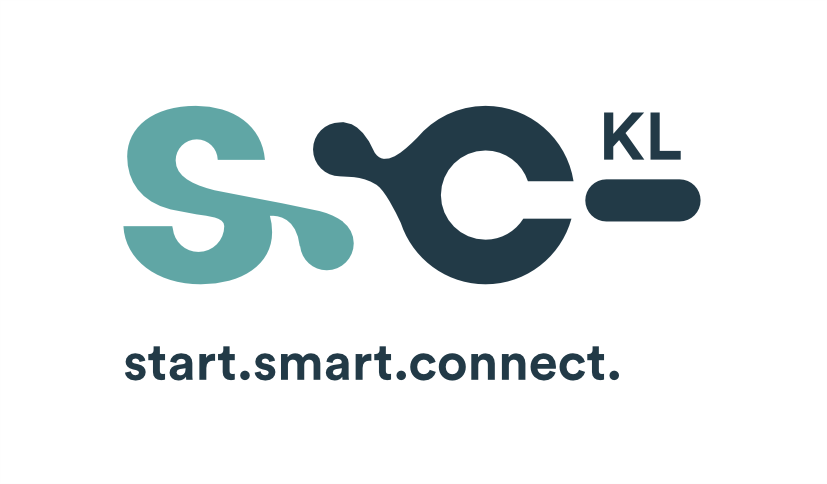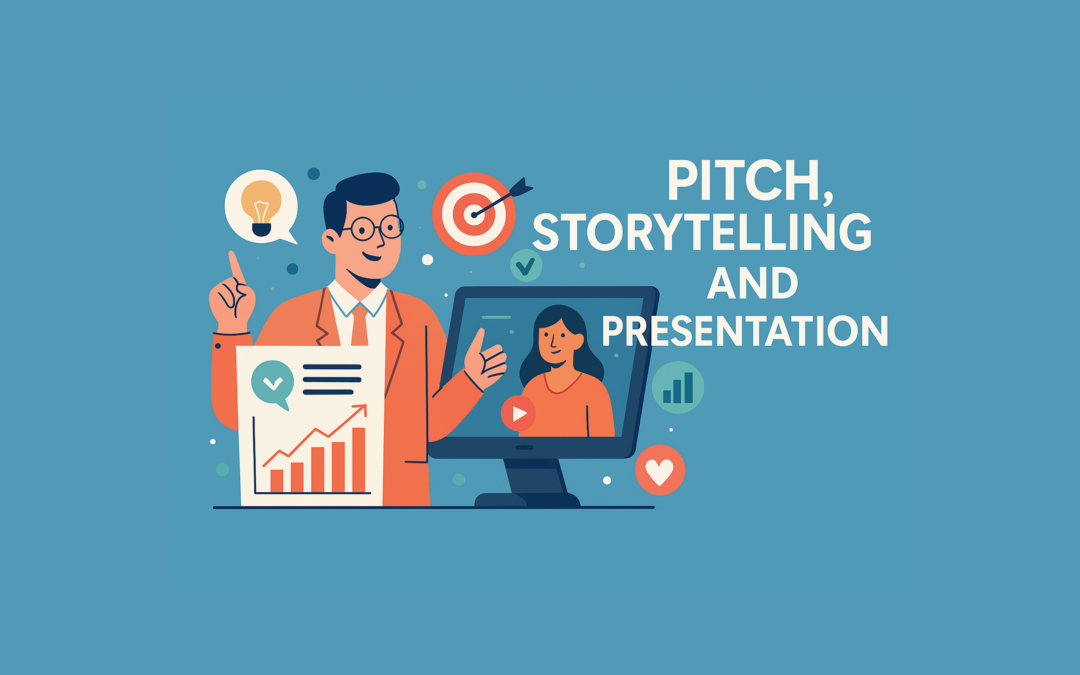Mastering the Art of Pitching: Presenting Your Business Idea with Impact:
A pitch is the presentation of a business idea to investors, banks, supporters and potential customers. The aim is to make it clear in just a few minutes what exactly you intend to do and why your idea is good. There are various factors that are relevant here. On the one hand, there is the argumentation logic you want to use to convince your target group. Secondly, your demeanour and rhetoric during the presentation and, of course, the presentation of your idea. We will also give you tips on how to make your slides clear and how to direct your audience’s attention. This course is not only suitable for preparing for a pitch, but will also help you with the structure and design of general presentations.
Video 1: Design - Logical structure and argumentation structure
Video 2: Design - Sorting data and building an argumentation structure
Video 3: Design - Technical basics in PowerPoint
Video 4: Design - Visual hierarchy
Video 5: Rhetoric and appearance
In addition to the content and argumentative structure of your pitch deck, it is important to optimise your rhetoric and appearance. In this video, our speakers explain how to prepare well for a presentation, how to assert yourself argumentatively and which demeanour is appropriate for a pitch or presentation.
Video 6: Pitch - Scientific presenation vs. Sales Pitch with Katharina Boguslawski
In this video, our expert Katharina Boguslawski gives you an insight in the Investors or customers mind and she shows you how to turn your scientific presentation into a wining pitch. The video is intended to assist you in adopting a different perspective, namely that of investors or customers.
Video 7: Storytelling
Video 8: Pitch decks and pitch types
Video 9: Pitch - The Guy-Kawasaki-Method (10-20-30-Method)
Further Information and additional content
Books and articles:
The 12 Magic Sliders: Insider Secrets for Raising Growth Capital by Paul M. Getty
30+ Beste Pitch Deck Beispiele, Tipps & Vorlagen von Venngage.com
Videos:
Best STARTUP PITCH ever. Silicon Valley. Hochgeladen von Jeff Bax am 26.10.2016
Ultimate Pitch Deck Guide with Examples. Hochgeladen von Raw Startup am 01.03.2022
What investors ACTUALLY want to see in your PITCH DECK. Hochgeladen von Matt C. Smith am 09.03.2021
Steve Jobs introduces iPhone in 2007. Hochgeladen von John Schroter am 09.10.2011
Podcasts:
#77 Die 13 häufigsten Pitch-Fehler und wie man sie verhindert von für-gruender.de
Startup-Radar von deutsche-startups.de-Podcast. Hochgeladen auf spotify
Best-Practice
We’ve selected three exciting examples that showcase how science can be transformed into real-world impact. If you’re looking for more inspiration, you can watch all 100 pitches from the day in the official YouTube playlist! 🎥✨
Mark focuses on addressing the communication challenges faced by the deaf and hard of hearing community in Ukraine. His innovation, zvuk.ai, is an AI-powered real-time transcription service with diarization. It transcribes conversations into text while identifying individual speakers, enabling users to participate fully in multi-person discussions. This project aims to empower the community by improving access to essential services and enhancing societal inclusion.
Upasana Jhariya is addressing heavy metal contamination in wastewater, which poses serious risks to ecosystems and human health. Her solution involves using microorganisms to produce biomaterials like jarosite and schwertmannite, which have high surface areas and exceptional adsorption capacities. This approach offers an environmentally friendly and cost-effective method for removing contaminants, ensuring clean and safe water without the need for harmful chemicals.
Ta-Shun Chou is developing Gallium Oxide (GaO) as a more efficient semiconductor material for energy transmission. Unlike silicon, which loses about 65% of generated energy in high-voltage applications, GaO has a five times higher bandgap and 3,000 times lower power loss, enabling reduced substation sizes. It will enhance energy efficiency and promote smarter energy use.
High-Tech Gründerfonds #Foundersclass
What is the High-Tech Gründerfonds (HTGF)?
High-Tech Gründerfonds (HTGF) is Germany’s leading seed investor for early-stage tech and high-tech startups. It offers initial funding of up to €1 million, with potential follow-on investments of up to €3 million.
More than just capital, HTGF provides access to an extensive network of industry partners, experienced co-investors, and startup-savvy experts. Founders benefit from hands-on support, strategic guidance, and real connections to scale their ideas.
HTGF focuses on digital tech, industrial tech, life sciences, and new materials – making it a strong partner for ambitious, science-driven startups ready to make an impact.
What is the High-Tech Gründerfonds #Foundersclass?
The #Foundersclass of High-Tech Gründerfonds (HTGF) is an initiative aimed at connecting founders and encouraging exchange within the startup community. Through regular events and formats, the #Foundersclass offers a platform for founders to share their experiences, learn from each other, and grow together.
This network helps overcome challenges and paves the way to success. Some of these events were recorded on video – we’re sharing them here with you. These videos are produced and published by HTGF on YouTube. We’re simply linking to them here.
FAQ - Frequently asked questions
How can I find a clear argumentation structure for my pitch?
Many founders find it difficult to break down their complex ideas into a few minutes. It is helpful to divide the structure into three parts: problem, solution, and benefit. You can supplement this basis with details such as market size, team, or business model. It is important that the central theme is immediately recognizable to the audience.
What do I do if I have too much data?
There is often a concern about leaving out important figures. Instead of showing everything, sort your data by relevance: Which figures most strongly support your core message? Everything else can be included in the appendix or in the discussion afterwards. Quality beats quantity.
Which technical basics in PowerPoint are really crucial?
Participants often ask if they need design experience. No—the basics are enough: a consistent design, legible font sizes, little text per slide, and the ability to present charts clearly. Clean formatting looks more professional than a cluttered layout.
How do I create visual hierarchy in my slides?
The most important messages should immediately catch the eye. You can achieve this with larger fonts, high-contrast colors, or clear separation of images and text. Rule of thumb: one slide = one central message.
How do I prepare rhetorically for objections?
A common question: “What if the audience asks critical questions?” The ABC method helps here: Acknowledge (“Good question”), Answer (briefly and specifically), and Check (“Does that help as an answer?”). This takes the pressure off and shows professionalism.
How can I practice my presentation skills?
It’s normal to feel uncertain on stage. Try recording yourself on video – this will help you recognize your gestures, posture, and speaking speed. Also, pay attention to your dress code: it’s better to be slightly overdressed than too casual. Body language and voice often contribute more to the effect than the slides.
How does a scientific presentation differ from a pitch?
Many researchers tend to go into great detail. A pitch, on the other hand, focuses on the benefits and relevance for the target audience—less methodology, more impact. It’s not about explaining every variable, but about creating enthusiasm and trust.
What does storytelling mean in a pitch?
Instead of stringing together numbers, you tell a story: Who is the target audience, what problem do they have, and how does your solution change their lives? Stories are easier to remember than pure facts and hold attention better.
What does a good pitch deck look like?
After the course, the question often remains: “Which slides are mandatory?” Typical components are: problem, solution, market, business model, competition, team, financial planning, and a clear call to action. The aim is not to show all the details, but to provide a convincing overview.
What is Guy Kawasaki’s 10-20-30 rule?
This rule helps to keep pitches concise: a maximum of 10 slides, no more than 20 minutes of speaking time, and a font size of at least 30 points. The aim is to avoid overload and focus on the essentials.
How do I deal with stage fright?
Nervousness is normal. Breathe consciously, speak a little slower at the beginning, and establish eye contact with the audience. Good preparation and a trial run will give you confidence. Tip: The audience usually doesn’t notice minor uncertainties.
Glossary
Visual Hierarchy
Short definition: Design principles that determine how content is perceived and prioritized.
Benefit: Facilitates understanding and directs attention.
Elements:
- Reading patterns: Typical eye movements (e.g., F-pattern, Z-pattern).
- Size & scaling: Important content is displayed larger.
- Layout: Logical structure (top/bottom, left/right).
- Colors & contrasts: Highlight differences, improve readability.
- Typography: Legibility and stylistic effect.
- Images & backgrounds: Support the message, must not overwhelm.
- Charts & tables: Present data clearly, simply, and visually.
- Emotion & creativity: Colors, images, and shapes to set mood and capture attention.
Rhetoric & Presence
Rhetoric
Short definition: The art of effective speaking.
Benefit: Convinces through clear arguments, language, and impact.
Presence
Short definition: Overall impression created by body language, voice, clothing, and confidence.
Benefit: Strengthens credibility and trust.
Preparation
Short definition: Structuring content, audience analysis, storyline.
Benefit: Prevents insecurity and improvisation mistakes.
ABC Analysis (Content)
Short definition: Prioritization of content into A (very important), B (important), C (supplementary).
Benefit: Keeps presentations focused on core messages.
Communication Alignment
Short definition: Tailoring messages to audience and context.
Benefit: Increases relevance and impact.
Technical & Organizational Preparation
Short definition: Checking technology, room, timing, and processes.
Benefit: Prevents disruptions during the presentation.
Delivery
Short definition: Presentation of content in front of an audience.
Benefit: Brings rhetorical and visual elements to life.
Rhetorical Toolkit
Short definition: Linguistic devices such as metaphors, comparisons, repetitions, pauses.
Benefit: Makes speeches more memorable and impactful.
Follow-Up
Short definition: Reflection on the presentation and follow-up with audience or investors.
Benefit: Secures learning effects and relationships.
Dress Code
Short definition: Clothing appropriate to context and audience.
Benefit: Supports professional impression.
Context & Audience
Short definition: Framework conditions (location, occasion, target group). Key question: What do I want to achieve with my pitch?
Benefit: Increases the relevance of language and presence.
Presentation Types
Scientific Presentation
Short definition: Focus on facts, methods, data, and evidence.
Benefit: Demonstrates seriousness and academic depth.
Example: Conference talk.
Sales Pitch
Short definition: Presentation aimed at convincing customers or investors.
Benefit: Highlights value, benefits, and unique features.
Example: Pitch for a new startup product.
Storytelling
Storytelling
Short definition: Conveying content through stories to create emotions and attention.
Benefit: Increases clarity and persuasive power.
Ethos
Short definition: Speaker’s credibility and character.
Benefit: Builds trust.
Pathos
Short definition: Emotional appeal to the audience.
Benefit: Creates closeness and enthusiasm.
Logos
Short definition: Logical and fact-based argumentation.
Benefit: Supports credibility.
Dramatic Arc
Short definition: Narrative structure that sustains interest.
Benefit: Maintains attention and enhances impact.
Call to Action (CTA)
Short definition: Concrete prompt for the audience to take action.
Benefit: Leads presentations to clear outcomes.
Example: “Invest in our project now.”
Benchmarks
Short definition: Comparison with established standards or best practices.
Benefit: Makes performance or potential tangible.
Dramatics
Short definition: Use of tension, contrasts, and emphasis.
Benefit: Adds emotional power to presentations.
Whitespace (Negative Space)
Short definition: Empty space in slides or layouts.
Benefit: Prevents overload, highlights content.
Data Graveyard
Short definition: Overloaded slides with too many numbers or text.
Benefit: Prevented by simplification, reduces misunderstandings.
Pitch Formats
Elevator Pitch
Short definition: Very short presentation (30–60 seconds) conveying the core idea.
Benefit: Ideal for sparking interest in the shortest time.
Example: “Our app saves researchers 30% of analysis time.”
Investor Pitch
Short definition: Detailed presentation focusing on business idea, market, team, and financial planning.
Benefit: Convinces investors to provide capital.
Example: 10-minute pitch for an EXIST startup to a VC.

Hi, i'm Lukas
and I manage the e-learning program. Do you have any further questions? Feel free to contact me via email: theisen@gruendungsbuero.info

